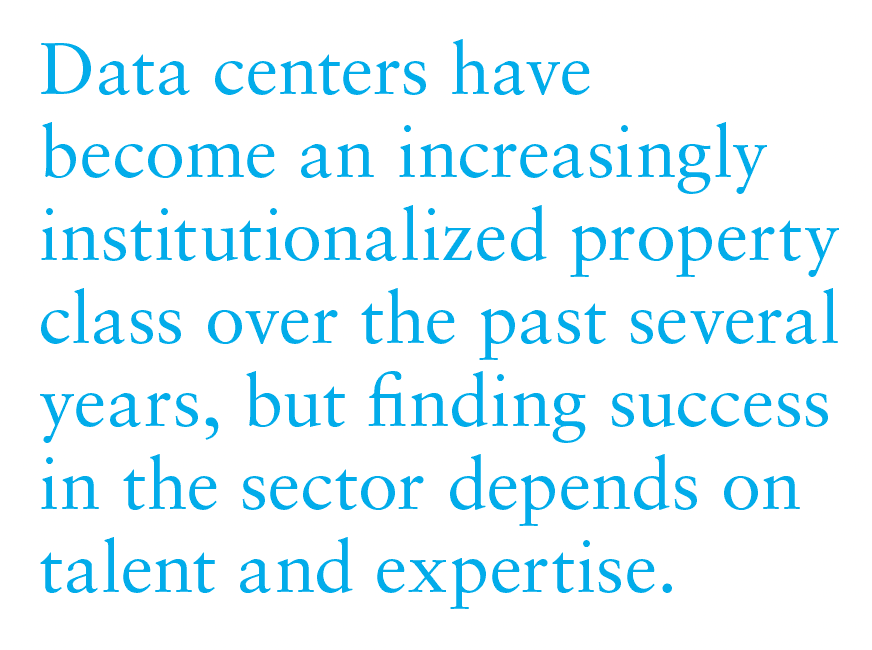Data centers have become increasingly institutionalized as a real estate asset class in the past few years. Even before the pandemic, they typically generated a strong return, and then they proved resilient during COVID.
It’s no wonder that CBRE recently reported that 31% of investors now want to invest in data centers, compared with only 2% in 2018.1
According to JLL, total M&A activity in the data center space hit US$47.1 billion in 2021, up from US$34.5 billion in 2020.2 In particular, some of the largest companies in the world with diversified business units, holdings, and innovations—also known as hyperscalers—are acquiring specialist data center developers to try and take advantage of increasing data center demand. Examples of this include KKR and GIP acquiring CyrusOne for US$15 billion in November 2021, and Blackstone Infrastructure Partners acquiring QTS Realty Trust for US$10 billion in June 2022.
However, even as the demand for data centers is set to increase, investors need to be aware of the unique challenges involved— including a growing shortage of experienced talent, which is essential to success in the sector.
DEMAND FOR DATA CENTERS IS INCREASING
According to Forbes: “Due to the widespread digital transformation and digitization of industries globally, 90% of the world’s data has been produced in the last two years.”3 Edge computing, which brings data storage closer to data sources, is booming.
The adoption of more hybrid work environments has also increased the need for better connectivity and access to systems. In addition to huge increases in the volume of data, governments are now imposing sovereignty laws which require data to be hosted in the country of the citizens of those countries. All these trends mean that the world needs a lot more data centers into the foreseeable future.
Importantly, due to the power needed to run data centers in North America and Europe, the cost of capital is high relative to many other asset classes. As a result, modular data centers that support better power and cooling system integration are on the rise. Compared with traditional brick-and-mortar facilities, these will result in lower carbon emissions and energy costs in the long run.
WHO ARE THE MAJOR PLAYERS IN THE SPACE?
Infrastructure, real estate, and private equity funds are all influential in this space, and each has specific strengths and weaknesses.
Infrastructure developers’ experience in building roads, tunnels, and ports is an advantage for data centers, which also involve dealing with regulation and the need to source large quantities of power and water.

Real estate developers’ experience of partnering with local or sector specialists on projects is useful and transferable to data center developments. These developers understand the fundamentals of location, tenancy, and development. However, as Francisco Porras of Merlin Properties explains, investors should be aware that they will need to constantly add capex into projects, because “data centers are typically all built-to-suit. It’s very different to an office building that can work for many different tenants.”
In that sense, real estate experience is mainly beneficial at the beginning of a data center development—the stage that involves land acquisition, licensing, and construction. On their data center projects, Merlin provides the capital and real estate expertise, and then partners with operations teams that have specialized (and hard-to-find) knowledge for data centers.
Private equity investors evaluate investments on a macro level and invest with customer demand in mind, which can be an advantage in this space. According to Eric Adler, CEO of PGIM Real Estate, data demands are the same for every country in the world. In fact, the demand might be greater in emerging countries than they would be for some developed countries. Therefore, PE investors are more comfortable than real estate developers to go into emerging markets.
DO NEW MARKET ENTRANTS STAND A CHANCE IN THIS SPACE?
There is a lot of interest from new market entrants in the data center space. Similar to the life sciences sector, data centers are inflation-proof, COVID-proof, require a long build time, have expensive set-up costs, come with high political and regulatory sensitivities, are in demand globally, and need highly specialized operators with deep knowledge of the end-user. This means the sector comes with high barriers to entry, especially given the high demand for energy and growing ESG concerns.
According to a recognized leader of cloud infrastructure at one of Sheffield Haworth’s client firms, the most important requirement for successful development in this sector is access to power, as data centers consume huge amounts of it—especially hyperscalers such as Google and Microsoft.
In the US, hyperscale data centers cost US$6–$10 million per megawatt to build. Although Europe’s development costs are typically comparable to the US, some locations are significantly higher, with Frankfurt recording a high of €22 million per megawatt and Bordeaux recording €39 million per megawatt. And while Asian markets benefit from lower labor, construction, and logistics costs, which reduces their average capital expenditure, the investment is still significant.

Compounding this problem is the fact that data center developers also need to purchase renewable energy from the grid or buy carbon credits due to internal or external goals or requirements to offset their carbon emissions. In both North America and Europe, large and small customers are increasingly more focused on becoming carbon zero or neutral. Lindsey Bruner, former Vice President of Project Development for CyrusOne, believes that adherence to both customer and internal targets for environmental consciousness on energy and water is now “more of a requirement than a differentiator,” as investors, developers, and end users continue to be more attentive to these considerations.
On this point, Eric Adler adds, “If you are a city which does not have reliable access to a renewable energy source, then anyone wanting to build a data center will need to put in the infrastructure to channel renewable energy to the city.”
Governments have recognized the drain on energy and water created by data centers. In Europe this has led to the introduction of the Climate Neutral Data Center Pact in 2021. Signatories to this pact include AWS, CyrusOne, Data4, Equinix, Gigas, Google or Atos, among others. This pact requires data centers to improve energy efficiency with measurable targets, including buying carbon-free energy and focusing on water conservation. Those investors with robust ESG agendas are unlikely to partner with firms who are not members.
A final barrier to entry is that the data center sector is still relatively small and thus tightly knit. In the US, newer entrants that have established a stronger presence in the sector either had the advantage of having a leadership team with prior data center experience, or else they’ve partnered with fi rms with existing track records, whether in real estate or infrastructure.
Despite this, the cloud infrastructure leader in our conversations argues that a new entrant lacking a track record in data center development could still be worth partnering with “if they have developed something on a similar scale and complexity” and have experience of large-scale capital deployment and seeking regulatory approval.
WHAT ARE KEY CONSIDERATIONS FROM A TALENT PERSPECTIVE?
As a relatively niche and immature sector—especially in Europe and Asia—data center developers face a shortage of experienced talent. In the US, while northern Virginia remains the largest data center market, other cities such as Dallas, Phoenix, and Chicago have growing development pipelines to support the increasing demand. In Europe, various markets are also experiencing a similar, rapid pace of growth. Across these markets, the essential question is the same: Where to source talent?
“There is certainly no shortage of capital but there is a shortage of skills and resources. There is no data center university or MBA program,” the cloud infrastructure leader points out. “However, the growth is so exponential that we are relying on cannibalizing competitors or trying to attract people from adjacent sectors.”
Bruner agrees, noting that “many firms are competing for experienced candidates.” Timing is an additional challenge, as the demand for talent in this space is urgent. Her view is that organizations need to “have a mindset of organizational design [rather] than hiring only for specific needs.” Given the shallow pool of specialist talent, fi rms must think more about skills-based hiring and also invest in training and educating their own talent in order to maintain a sustainable workforce. That said, with the level of competition in the space, it is still important to prioritize candidates who bring existing familiarity with and knowledge of the sector, as this can provide organizations with an edge.
“Whether you are an infrastructure, real estate, or private equity investor, the most important thing is that you know what the end user wants. Data centers need to be highly tailored to the end user, which means that suitable data centers are typically built to suit or newly built with the current needs of the tenant front of mind,” the cloud infrastructure adds.
Some developers are hiring engineers from heavy industrial sectors, such as oil and gas and manufacturing, due to the unique technical needs of data centers. Because data centers represent a convergence of real estate and infrastructure, those with experience leading complex processes involving multiple stakeholders at pace can work well in the data center context. This is especially true of those with experience of energy procurement and management.
According to Francisco Porras at Merlin Properties, the key to success in data center developments is similar to development of other real estate sectors: hiring hands-on technical professionals who understand their tenants and are customer oriented. However, the tenant requirements in data centers are more specific and are changing more rapidly compared to other real estate asset classes such as offices, which means that you need people who can stay up to date with regulations and be more flexible.
WHAT SHOULD INVESTORS LOOK FOR?
As we’ve discussed, the data center market comes with a series of very specific challenges to deter the unwary investor. ESG considerations are key, especially when it comes to sourcing renewable energy and conserving water usage. At the same time, most data center developments are highly bespoke. These factors all increase the capex of such investments.
When it comes to established operators, investors would do well to seek out those with a track record in the sector, while new market entrants with access to large amounts of capital and relevant experience from adjacent markets are also likely to thrive.
EXPLORE THE LATEST ISSUE

CAPITAL MARKETS PULSE
Through the rest of this year, investors forecast challenges for global capital, but thoughtful investors are forging ahead.
Gunnar Branson and Benjamin van Loon | AFIRE
ON/OFF SWITCH
While the market rarely sends clear investing signals, current market conditions are replete with clues, but as timing for corrections is difficult, a move to risk-off strategies could be useful.
Joseph L. Pagliari | University of Chicago
MOBILE ZONING
Mobile information technology has upended US land use regulation, and the ramifications of this technological upheaval are finally coming into view.
Robert Seldin | Madison Highland Live Work Lofts
GET SMART
As buildings become increasingly technologized, especially after the pandemic, cyber-attacks can put entire properties at risk and require a firmwide security approach.
Noëlle Brisson and Michael Savoie | CyberReady, LLC
HEDGE TRIMMING
The rapid rise in consumer prices has rekindled the old debate about whether commercial real estate provides a long-term hedge against inflation (hint: look at multifamily).
Gleb Nechayev, CRE | Berkshire Residential Investments
THE NEW SCIENCE
While the real estate industry has long understood the need for data, it still struggles with connecting information to decision making. New strides in data science could change that.
Brian Biggs and Ashton Sein | Grosvenor
BRACE FOR IMPACT
The practice and expectations of investing across all industries is undergoing major upheaval and the key to stability will mean looking beyond profit for profit’s sake.
Michael Cooper and Richard Florida | Dream Unlimited Corporation
TRANSITION PLANS
Forecasts about the future of the office sector are often wildly conflicting, but the looming high tide of generational leadership transitions could change the script.
Sabrina Unger and Britteni Lupe | American Realty Advisors
WHAT DRIVES LOGISTICS?
The logistics sector was the winner of the pandemic recession—but is its rise built to last?
Hugues Braconnier and Dr. Megan Walters | Allianz Real Estate
RENEWED PURPOSE
From retail to office to abandoned factories and warehouses, owners of real estate are rethinking—and reinventing—the future of their investments.
John Thomas and Stacey Krumin | Squire Patton Boggs
DATABASICS
Data centers have become an increasingly institutionalized property class over the past several years, but finding success in the sector depends on talent and expertise.
Max Shepherd, Jannah Babasa, and Isabel Ruiz Halter | Sheffield Haworth
COOPERATIVE INVESTMENT
As insurance costs of residential and commercial spiral out of control, a 1400-year-old tradition is poised to offer long-term, sustainable growth for real estate investments.
Ishmam Ahmed | Georgetown University & AFIRE
DOMESTIC MIGRATION TRENDS
Dive into the report to understand if and how COVID impacted domestic migration patterns on a state, city, and zip code level.
Ethan Chernofsky | Placer.ai
UP FRONT
How does the Consumer Price Index account for the cost of housing?
David Wessel and Sophia Campbell | The Brookings Institution

—
ABOUT THE AUTHOR
Max Shepherd, Executive Director, London; Isabel Ruiz Halter, Director, London; and Jannah Babasa, Vice President, New York; work for the Global Real Assets Practice for Sheffield Haworth, an executive firm that provides highly tailored executive search and talent advisory services to help financial services companies find, attract, and retain talent.
—
NOTES
* Many thanks to our contributors: Eric Adler, President and CEO, PGIM Real Estate; Lindsey Bruner, VP Project Development, CyrusOne, and Francisco Porras, Leasing Manager, Merlin Properties.
1 “Investor interest in data centers continues to spike into 2022, 15 fold since 2018,” CBRE, updated February 3, 2022, cbre.com/press-releases/investor-interest-in-datacentres-continues-to-spike-into-2022.
2 Sharon Fisher, “JLL: 2021 Smashed Data Center Records,” updated April 4, 2022, datacenterknowledge.com/colocation/jll-2021-smashed-data-center-records.
3 Bernard Marr, “How Much Data Do We Create Every Day? The Mind-Blowing Stats Everyone Should Read,” updated May 21, 2018, forbes.com/sites/bernardmarr/2018/05/21.
THIS ISSUE OF SUMMIT JOURNAL IS PROUDLY SUPPORTED BY
Aegon Asset Management is an active global investor that manages and advises on assets of $328 billion* for global pension plans, public funds, insurance companies, banks, wealth managers, family offices, and foundations. Aegon AM’s Real Assets platform focuses on delivering yield-oriented and total return solutions spanning the risk/return spectrum.
With an over 35-year history and $25 billion* in AUM/AUA, the Real Assets business is built on a cycle-tested platform, deep and broad market access, and long-term relationships.
Our real assets debt and equity strategies seek to deliver strong relative value and returns through a research-intensive process. The process encompasses thoughtful top-down research and intelligent bottom-up analysis deployed by an experienced multidisciplined team of over 110 investment professionals.*
Each capability is underpinned by dedicated, in-house support and service teams including applied research, engineering and environmental, valuation, accounting, client service, legal and risk management.
*As of June 30, 2022. The assets under management/advisement described herein incorporates the entities within Aegon Asset Management brand as well as the following affiliates: Aegon Asset Management Holding B.V., Aegon Asset Management Spain, and joint-venture participations in Aegon Industrial Fund Management Co. LTD, La Banque Postale Asset Management SA, and Pelargos Capital BV.




